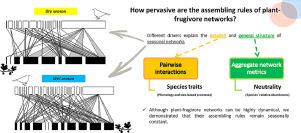当前位置:
X-MOL 学术
›
Ecol. Complex.
›
论文详情
Our official English website, www.x-mol.net, welcomes your
feedback! (Note: you will need to create a separate account there.)
Seasonal consistency of the assembling rules in a bird-fruiting plant network
Ecological Complexity ( IF 3.1 ) Pub Date : 2020-12-01 , DOI: 10.1016/j.ecocom.2020.100869 Luís Paulo Pires , Celine de Melo
Ecological Complexity ( IF 3.1 ) Pub Date : 2020-12-01 , DOI: 10.1016/j.ecocom.2020.100869 Luís Paulo Pires , Celine de Melo

|
Abstract There is an ongoing debate on whether species' traits or neutrality generate recurrent patterns of mutualistic networks. Although there have been recent advances on the issue, many studies neglect the seasonal dynamics of these drivers. In this study, we investigated how pervasive are the drivers (i.e. species’ size, phenological overlap and species relative abundance) of the frequency of pairwise interactions and the aggregate metrics of seasonal seed dispersal networks in a semideciduous forest from the savannahs of Southeastern Brazil. We used a likelihood approach and built probability matrices based on different drivers to compare how they fit in the frequency and structure of the seasonal observed networks. We found that in both seasons trait-based processes, especially phenological overlap between species, best predicted the frequency of pairwise interactions. However, species relative abundances performed better than species traits in explaining most of aggregate network metrics in both seasons, except for the interaction evenness. These findings suggest that ecological and evolutionary processes are seasonally pervasive and determine the ability of species to interact with their partners. Besides, the general structure of the seasonal networks is less sensitive to species traits and its drivers remain seasonally constant. We conclude that our ability to understand the complexity of plant-frugivore interactions depends on assessing the contribution of species traits and their relative abundances to the structure of seasonal-detailed networks.
中文翻译:

鸟类果实植物网络中组装规则的季节性一致性
摘要 关于物种的特征或中立性是否会产生互惠网络的循环模式,目前一直存在争论。尽管最近在这个问题上取得了进展,但许多研究忽略了这些驱动因素的季节性动态。在这项研究中,我们调查了巴西东南部大草原半落叶林中成对相互作用频率的驱动因素(即物种大小、物候重叠和物种相对丰度)的普遍性和季节性种子传播网络的总体指标。我们使用似然方法并基于不同的驱动因素构建概率矩阵,以比较它们如何适应季节性观察网络的频率和结构。我们发现,在两个季节基于性状的过程,特别是物种之间的物候重叠,最好地预测了成对相互作用的频率。然而,除了相互作用的均匀性外,物种相对丰度在解释两个季节的大多数聚合网络指标方面表现优于物种特征。这些发现表明,生态和进化过程具有季节性,并且决定了物种与其伙伴互动的能力。此外,季节性网络的一般结构对物种特征不太敏感,其驱动因素保持季节性不变。我们得出的结论是,我们理解植物-食果动物相互作用复杂性的能力取决于评估物种特征及其相对丰度对季节性详细网络结构的贡献。除了相互作用的均匀性外,物种相对丰度在解释两个季节的大多数聚合网络指标方面表现优于物种特征。这些发现表明,生态和进化过程具有季节性,并且决定了物种与其伙伴互动的能力。此外,季节性网络的一般结构对物种特征不太敏感,其驱动因素保持季节性不变。我们得出的结论是,我们理解植物-食果动物相互作用复杂性的能力取决于评估物种特征及其相对丰度对季节性详细网络结构的贡献。除了相互作用的均匀性外,物种相对丰度在解释两个季节的大多数聚合网络指标方面表现优于物种特征。这些发现表明,生态和进化过程具有季节性,并决定了物种与其伙伴互动的能力。此外,季节性网络的一般结构对物种特征不太敏感,其驱动因素保持季节性不变。我们得出的结论是,我们理解植物-食果动物相互作用复杂性的能力取决于评估物种特征及其相对丰度对季节性详细网络结构的贡献。这些发现表明,生态和进化过程具有季节性,并且决定了物种与其伙伴互动的能力。此外,季节性网络的一般结构对物种特征不太敏感,其驱动因素保持季节性不变。我们得出结论,我们理解植物-食果动物相互作用复杂性的能力取决于评估物种特征及其相对丰度对季节性详细网络结构的贡献。这些发现表明,生态和进化过程具有季节性,并且决定了物种与其伙伴互动的能力。此外,季节性网络的一般结构对物种特征不太敏感,其驱动因素保持季节性不变。我们得出的结论是,我们理解植物-食果动物相互作用复杂性的能力取决于评估物种特征及其相对丰度对季节性详细网络结构的贡献。
更新日期:2020-12-01
中文翻译:

鸟类果实植物网络中组装规则的季节性一致性
摘要 关于物种的特征或中立性是否会产生互惠网络的循环模式,目前一直存在争论。尽管最近在这个问题上取得了进展,但许多研究忽略了这些驱动因素的季节性动态。在这项研究中,我们调查了巴西东南部大草原半落叶林中成对相互作用频率的驱动因素(即物种大小、物候重叠和物种相对丰度)的普遍性和季节性种子传播网络的总体指标。我们使用似然方法并基于不同的驱动因素构建概率矩阵,以比较它们如何适应季节性观察网络的频率和结构。我们发现,在两个季节基于性状的过程,特别是物种之间的物候重叠,最好地预测了成对相互作用的频率。然而,除了相互作用的均匀性外,物种相对丰度在解释两个季节的大多数聚合网络指标方面表现优于物种特征。这些发现表明,生态和进化过程具有季节性,并且决定了物种与其伙伴互动的能力。此外,季节性网络的一般结构对物种特征不太敏感,其驱动因素保持季节性不变。我们得出的结论是,我们理解植物-食果动物相互作用复杂性的能力取决于评估物种特征及其相对丰度对季节性详细网络结构的贡献。除了相互作用的均匀性外,物种相对丰度在解释两个季节的大多数聚合网络指标方面表现优于物种特征。这些发现表明,生态和进化过程具有季节性,并且决定了物种与其伙伴互动的能力。此外,季节性网络的一般结构对物种特征不太敏感,其驱动因素保持季节性不变。我们得出的结论是,我们理解植物-食果动物相互作用复杂性的能力取决于评估物种特征及其相对丰度对季节性详细网络结构的贡献。除了相互作用的均匀性外,物种相对丰度在解释两个季节的大多数聚合网络指标方面表现优于物种特征。这些发现表明,生态和进化过程具有季节性,并决定了物种与其伙伴互动的能力。此外,季节性网络的一般结构对物种特征不太敏感,其驱动因素保持季节性不变。我们得出的结论是,我们理解植物-食果动物相互作用复杂性的能力取决于评估物种特征及其相对丰度对季节性详细网络结构的贡献。这些发现表明,生态和进化过程具有季节性,并且决定了物种与其伙伴互动的能力。此外,季节性网络的一般结构对物种特征不太敏感,其驱动因素保持季节性不变。我们得出结论,我们理解植物-食果动物相互作用复杂性的能力取决于评估物种特征及其相对丰度对季节性详细网络结构的贡献。这些发现表明,生态和进化过程具有季节性,并且决定了物种与其伙伴互动的能力。此外,季节性网络的一般结构对物种特征不太敏感,其驱动因素保持季节性不变。我们得出的结论是,我们理解植物-食果动物相互作用复杂性的能力取决于评估物种特征及其相对丰度对季节性详细网络结构的贡献。











































 京公网安备 11010802027423号
京公网安备 11010802027423号